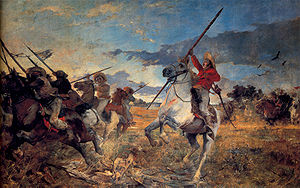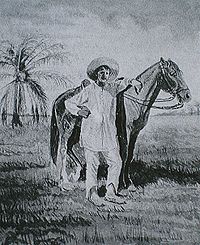- Llanero
-
 Maria Nieves was an Apurean Llanero that inspired a character in Rómulo Gallegos Doña Barbara. This photograph in 1920, shows him ready to guide the cattle to cross the Apure River.
Maria Nieves was an Apurean Llanero that inspired a character in Rómulo Gallegos Doña Barbara. This photograph in 1920, shows him ready to guide the cattle to cross the Apure River.
A llanero (Spanish pronunciation: [ʝaˈneɾo], plainsman) is a Venezuelan or Colombian herder. The name is taken from the Llanos grasslands occupying western Venezuela and eastern Colombia. The Llanero were originally part Spanish and Indian and have a strong culture including a distinctive form of music.
During the wars of independence, Llaneros served in both armies and provided the bulk of the cavalry during the war. In 1819, an army of Llaneros, led by Simón Bolívar and José Antonio Páez, defeated the Spanish with a surprise attack when they crossed over the Orinoco plains and the Andes mountains.
Contents
History
Prior to Spanish settlement in 1548, the Llanos were occupied by indigenous groups. Andalusian monks established settlements close to native American villages and accomplished conversion through a mixture of persuasion and force.
The Spaniards started to graze cattle on the grasslands of the llanos and the Llanero were originally a mixture of Spaniards and Indians. Indeed, Llaneros still use many terms dating from the 16th and 17th centuries. From 1640 to 1790, outlaw slaves lived in cumbes, or outlaw slave communities, and intermarried with the Llanero.
By the end of the 18th century, the region exported 30,000 mules a year to the Antilles and salted meat for the 1.5 million slaves there and in Cuba. There were 1.2 million cattle in the area by 1815.
When the Wars of Liberation started, the Spanish enlisted the Llaneros, playing on their dislike of the criollos of the independence movement. Bolívar realized that the plains were critical to success in the wars of liberation – they offered freedom of movement, as well as the capacity to feed his army.
 Arturo Michelena, Vuelvan Caras. The painting depicts an incident at the Battle of Las Queseras del Medio, in which José Antonio Páez ordered his llaneros to turn around and attack the Spanish cavalry that was pursuing them.
Arturo Michelena, Vuelvan Caras. The painting depicts an incident at the Battle of Las Queseras del Medio, in which José Antonio Páez ordered his llaneros to turn around and attack the Spanish cavalry that was pursuing them.
He therefore sought to enlist the Llaneros to his cause and gradually succeeded by enduring the same hardships as they did – the Llaneros called him culo de hierro – or "iron buttocks" – for his endurance on horseback.
The Llaneros led by Páez proved crucial in Bolivar's campaign. After leading his forces including the Llanero troops over the eastern Andes, Bolívar won a critical victory at the Battle of Boyacá on August 7, 1819. Three days later, he captured Bogotá in what was the turning point of wars of liberation.
The Llaneros would also prove to be vital in future battles in the campaign. Páez's Bravos de Apure or lancers were again critical in the Battle of Carabobo on June 24, 1821, and allowed Bolivar to capture Caracas. Páez would become the first President of Venezuela.
During the 1850's, a hide boom stimulated the local economy. A boom in Great Egret feathers in the early 1930's in Europe led to them being called white gold until the trade was banned.
Llanero culture
Cattle form an important part of Llanero culture. There are 12 million cattle on the llano. During the year, the Llaneros have to drive cattle great distances. During the winter wet season, the Llaneros have to drive the cattle to higher ground as the poor drainage of the plains means that the annual floods are extensive. Conversely, they have to drive the cattle towards wet areas during the dry summer.
The Llaneros show their skills in coleo competitions, similar to rodeos, where they compete to drag cattle to the ground.
Llanero music is distinctive for its use of the harp, the maracas and a small guitar called a cuatro. The joropo, a Llanero dance, has become the national dance of Venezuela, and of the Llanos of Colombia. While Llanero music is relatively unknown outside of Venezuela and Colombia, the musical groups Los Llaneros and Cimarron have toured throughout the world.
Llanero cuisine is based on meat, fish, chicken, "chiguire" meat (also known as capybara), rice, arepas, and other starches, although wheat is not used. Llanero Ken, a doll dressed in the distinctive Llanero costume Liqui liqui, including a customary starched hat, has become a popular doll in Venezuela.
North American usage
The Spanish also used the term to describe the nomadic tribes of the Llano Estacado of Texas and New Mexico and was applied to the Apache in particular.
In Spanish, The Lone Ranger is known as El Llanero Solitario.
See also
- Vaquero and cowboy (Mexico and United States)
- Gaucho (Argentina, Uruguay and Brazil)
- Morochuco (Peruvian Andean)
- Piajeno (north coast mule rider of Peru: Piura and Lambayeque)
- Charro (Mexican cowboy, nomad and bandolero)
- Guajiro (Cuba)
- Huaso (Chile)
- Jíbaro (Puerto Rico)
- Chagra (Ecuador)
- Lancero
Further reading
- Richard Slatta, Cowboys of the Americas, Yale University Press, New Haven, 1990
- Donald Mabry, Colonial Latin America, Llumina Press, 2002
Further reference
- About.com article on the Llaneros
- Llanera music
- Donald Mabry article on Military Aspects of Venezuelan independence
- Last Frontiers article on the Llanos
- Handbook of Texas Online
Mounted stock herders Categories:- Agricultural occupations (animal)
- Colombian culture
- Venezuelan society
- Venezuelan culture
Wikimedia Foundation. 2010.



